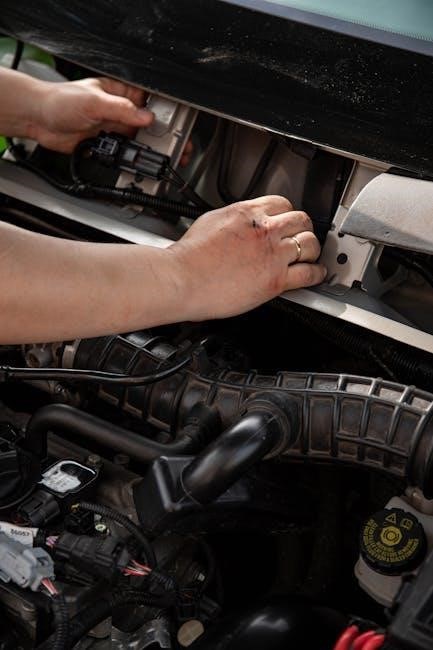rover mower parts list manuals
Understanding Rover Mower Manuals
Rover mower manuals are essential guides providing safety instructions, maintenance tips, and parts lists. They help users understand operation, troubleshooting, and optimal performance for their equipment.
1.1 Types of Manuals Available
Rover mower manuals come in various formats to cater to different user needs. These include user manuals, which provide detailed instructions for operation and maintenance, and parts lists, essential for identifying and ordering spare parts. Additionally, operator manuals focus on safe usage and troubleshooting, while service manuals offer in-depth repair guidance for advanced users. Some manuals are model-specific, such as those for the Rover Mini Rider Hydro or Pro Cut 560, ensuring precise information. Others, like the Domestic Rotary Mower manual, cover general maintenance tips. Manuals are available in PDF format, making them easily accessible for download. They also include safety precautions, warranty details, and diagrams for clarity. Whether you’re assembling, maintaining, or repairing your mower, Rover provides comprehensive resources to ensure optimal performance and safety.
1.2 Key Components of a Rover Mower Manual
A Rover mower manual typically includes several key components to ensure comprehensive understanding and safe operation. These components often feature safety instructions, detailing precautions to prevent accidents and ensure proper handling. The manual also includes a detailed parts list, which helps users identify components for maintenance or replacement. Maintenance schedules are provided to guide routine upkeep, such as oil changes and blade sharpening. Additionally, the manual covers troubleshooting sections to diagnose and resolve common issues. Assembly and operation instructions are also included, along with warranty information and customer support details. Many manuals incorporate visual aids like diagrams and illustrations to clarify complex procedures. Finally, they often emphasize eco-friendly practices and storage tips to prolong the mower’s lifespan and environmental efficiency.
1.3 Symbols and Terminology Used
Rover mower manuals utilize specific symbols and terminology to convey critical information clearly. Common symbols include warning signs for hazards, caution indicators for safety precautions, and instructional icons guiding assembly or maintenance. Terminology often includes terms like self-propelled, mulching, and blade engagement. These terms ensure users understand operational features and components. The manuals also define technical phrases, such as cutting height adjustment and oil capacity, to aid in proper mower setup and maintenance. Familiarizing oneself with these symbols and terms is essential for safe and effective use of the equipment, as well as for troubleshooting and repairs. Always refer to the manual’s glossary or symbol key for clarification if unsure of any notation or terminology.

Rover Mower Parts List
Rover mower parts lists detail essential components like blades, engines, wheels, and cutting decks. These manuals also cover accessories such as grass bags and mulching kits, ensuring comprehensive maintenance and repair guidance.
2.1 Overview of Parts and Accessories
Rover mower manuals provide a detailed overview of parts and accessories, ensuring users can identify and maintain every component. Key components include blades, engines, wheels, and cutting decks, each playing a crucial role in mower functionality. Accessories like grass bags, mulching kits, and replacement belts are also highlighted, offering options for enhanced performance. The manuals often include diagrams and descriptions to help users understand the purpose and location of each part. This section is invaluable for troubleshooting and ensuring proper maintenance, as it provides a clear reference for identifying and replacing worn or damaged components. By familiarizing yourself with the parts list, you can keep your Rover mower in optimal condition and extend its lifespan. This comprehensive guide ensures users have everything they need to maintain and repair their equipment effectively.
2.2 Essential Components of Rover Mowers
Rover mowers are built with durable and functional components designed for optimal performance. The engine, whether petrol or electric, powers the mower and is a critical part of its operation. The cutting blade is essential for grass cutting, requiring regular sharpening and maintenance. Wheels and transmission enable smooth movement, especially on larger lawns, while the chassis provides structural support. The handlebar offers control and comfort during operation. These components work together to ensure efficient mowing and longevity of the equipment. Understanding each part’s role helps in maintaining and troubleshooting the mower effectively. Regular maintenance, as outlined in the manual, keeps these components in top condition, ensuring your Rover mower performs reliably season after season.
2.3 Locating Parts Lists in Manuals
Parts lists in Rover mower manuals are typically found in the later sections, often labeled as “Parts List” or “Spare Parts Catalog.” These lists provide detailed diagrams and descriptions of each component, including part numbers and availability. Users can refer to these lists to identify parts needing replacement or maintenance. The manual may also include a table of contents or index to quickly locate the parts section. Additionally, diagrams often highlight components like blades, engines, and wheels, making it easier to identify and order replacements. Always cross-reference part numbers with the manufacturer’s official list to ensure accuracy. This section is invaluable for DIY repairs and routine maintenance, helping users keep their Rover mower in optimal condition. By following the manual’s guidance, users can efficiently manage parts identification and procurement.

Maintenance and Troubleshooting
Routine checks include blade sharpening, oil changes, and spark plug maintenance. Troubleshoot issues like blade jams or engine failure by referencing the manual for step-by-step solutions.
3.1 Routine Maintenance Procedures
Routine maintenance is crucial for optimal performance of your Rover mower. Start by regularly inspecting and sharpening the cutting blade to ensure clean cuts and prevent grass tearing. Check the oil level before each use and change it as recommended to keep the engine running smoothly. Additionally, clean the mower deck and remove any debris to maintain airflow and prevent rust. The manual also advises disconnecting the spark plug lead before performing any maintenance to avoid accidental starts. Lubricate moving parts periodically to reduce wear and tear. Lastly, check the air filter and replace it if necessary to ensure proper engine function. By following these steps, you can extend the life of your mower and maintain its efficiency.
3.2 Diagnosing Common Issues
Common issues with Rover mowers often relate to startup problems, blade functionality, or engine performance. If the mower fails to start, check the spark plug, fuel level, and air filter. A jammed blade may indicate debris buildup or a dull edge. Uneven cutting could result from an unbalanced blade or incorrect height settings. Engine issues, such as overheating or reduced power, might stem from a blocked air filter or low oil levels. For transmission problems, ensure the drive system is clear of obstructions and fluid levels are adequate. Refer to the manual for troubleshooting guides specific to your model, as it provides detailed diagnostic steps and solutions. By identifying symptoms early, you can address issues before they escalate, ensuring optimal performance and longevity of your mower.
3.3 Step-by-Step Repair Procedures
Repairing your Rover mower involves systematic steps to ensure effectiveness and safety. Always disconnect the spark plug before starting any repair to prevent accidental startups. Begin by identifying the specific issue, then consult the manual for model-specific instructions. For blade replacement, remove the deck, take out the old blade, and install a new one, ensuring proper alignment. If the engine isn’t starting, check the fuel, air filter, and spark plug. Clean or replace the air filter, and ensure the fuel is fresh. For transmission issues, inspect for debris and lubricate moving parts. After completing repairs, test the mower to ensure proper function. Regularly referencing the manual ensures adherence to manufacturer guidelines, minimizing risks and extending the mower’s lifespan. Proper repair procedures help maintain performance and safety, keeping your Rover mower in optimal condition for years.

Safety Precautions and Guidelines
Always disconnect the spark plug before maintenance to prevent accidental starts. Wear protective gear and keep children away. Follow manual instructions for safe operation and handling.
4.1 General Safety Tips for Mower Operation
Ensure safety by disconnecting the spark plug before maintenance. Wear protective gear like gloves and eyewear. Keep loose clothing tied back and avoid jewelry. Operate mowers on level ground and never leave them unattended. Keep children and pets away. Avoid mowing in wet conditions or near water. Follow manual instructions for proper handling. Always maintain a firm grip and stay alert. Never reach under the mower while it’s running. Use only genuine Rover parts for repairs. Regularly check blades and ensure they are secure. Familiarize yourself with controls before use. Mow at a steady pace and avoid sudden turns. Store the mower in a dry, secure location. Refer to the manual for model-specific safety guidelines to ensure optimal performance and user protection.
4.2 Pre-Operation Checks and Safety Measures
Before starting your Rover mower, perform a thorough pre-operation check. Inspect the mower deck for damage or blockages. Ensure all bolts and screws are tightened securely. Check the blade for wear or damage and replace if necessary. Verify the oil and fuel levels, refilling as needed. Examine the air filter and clean or replace it if dirty. Ensure the spark plug is securely connected. Test all controls to ensure proper function. Check tire pressure and adjust according to the manual; Look for any signs of wear on belts and cables. Remove any debris from the mowing deck and chute. Always disconnect the spark plug when performing maintenance. Make sure the area is clear of obstacles and children. Follow the manual’s guidelines for specific model checks to ensure safe and efficient operation.
4.3 Handling Emergencies and Accidents
In case of an emergency, immediately turn off the mower’s engine and disconnect the spark plug to prevent accidental startups. If the mower catches fire, use a fire extinguisher rated for combustible materials. Never use water on fuel or oil fires. For blade-related accidents, stop the mower instantly and avoid reaching under the deck while it is running. If someone is injured, provide first aid and seek medical attention promptly. Always keep a phone nearby for emergencies. If the mower becomes jammed, turn it off and carefully inspect for blockages. Never use your hands to clear debris; instead, use a stick or tool. After any incident, inspect the mower for damage and repair it before resuming use. Regular maintenance can help prevent many emergencies. Keep emergency contact numbers handy and ensure others know how to respond if an accident occurs.

Downloading and Accessing Manuals
Rover mower manuals are easily accessible online, with popular models like the Rover Mini Rider Hydro available for free download. Ensure safe and proper mower operation by referring to these guides.
5.1 How to Download Rover Mower Manuals
To download Rover mower manuals, visit official websites or trusted platforms like ManualsLib. Use the search bar, enter your model number, and select the appropriate manual. Ensure the source is reliable to avoid incorrect information.
5.2 Popular Rover Mower Models and Their Manuals
Popular Rover mower models include the Mini Rider Hydro, Pro Cut 560, and Raider 439/38. Each model’s manual is available for download, offering detailed instructions on operation, maintenance, and troubleshooting specific to that mower.
5.3 Official Sources for Manuals
Official Rover mower manuals are available through authorized sources like Manuals.ca and Rover’s official website. These platforms offer free downloads of PDF manuals for models such as the Rover Mini Rider Hydro, Pro Cut 560, and Raider 439/38. Users can search by model number or product name to find the specific manual they need. These manuals are comprehensive, covering safety guidelines, assembly, operation, and maintenance. They also include detailed parts lists and troubleshooting tips. For older or discontinued models, official sources often archive manuals, ensuring accessibility. Always verify the source to ensure authenticity and safety. Official manuals are indispensable for optimal mower performance and user safety.
Rover offers a range of mower models, including push, self-propelled, and ride-on options, designed for efficiency and durability. Popular models like the Raider and Mini Rider are user favorites.
6.1 Types of Rover Mower Models Available
Rover offers a diverse range of mower models catering to different lawn care needs. These include push mowers, self-propelled mowers, ride-on mowers, and zero-turn mowers. Push mowers are ideal for small to medium-sized lawns, while self-propelled models provide ease of use with automatic propulsion. Ride-on mowers are perfect for larger areas, offering comfort and efficiency. Zero-turn mowers are designed for precision and maneuverability, suitable for complex lawn layouts. Additionally, Rover provides specialized models like the Rover Mini Rider Hydro, Rover Pro Cut 560, and Rover Raider 439/38, each tailored for specific tasks and terrains. These models vary in features such as cutting widths, engine types, and additional functionalities like mulching or catching grass clippings, ensuring there’s a Rover mower to suit every homeowner’s or professional’s requirements.
6.2 Model-Specific Manuals and Features
Each Rover mower model comes with a detailed manual tailored to its unique features and specifications. For instance, the Rover Pro Cut 560 manual emphasizes its robust engine and wide cutting deck, providing instructions for optimal performance. The Rover Raider 439/38 manual highlights its advanced transmission system and safety features. Manuals for models like the Rover Mini Rider Hydro include specific guidelines for hydrostatic transmission maintenance. These guides ensure users understand model-specific components, such as variable speed controls or mulching capabilities. By referring to these manuals, users can maximize their mower’s efficiency and longevity. Additionally, model-specific troubleshooting sections help diagnose and resolve common issues particular to each mower type, ensuring seamless operation and minimizing downtime.
6.3 Key Features and Capabilities
Rover mowers are designed with innovative features to enhance performance and user convenience. Models like the Rover Pro Cut 560 boast wide cutting decks for efficient lawn maintenance, while the Raider 439/38 offers advanced transmission systems for smooth operation. Many models include variable speed controls, allowing users to adjust mowing pace according to terrain. Additionally, some mowers feature mulching capabilities, converting grass clippings into nutrient-rich fertilizer. Eco-friendly designs emphasize fuel efficiency and reduced emissions, aligning with environmental standards. Robust engines ensure durability, even for heavy-duty tasks. These capabilities make Rover mowers versatile for diverse lawn sizes and types, delivering precise cuts and minimizing mowing time. By integrating advanced technology and user-centric features, Rover mowers cater to both residential and commercial needs, ensuring a seamless and effective mowing experience.

Common Issues and DIY Repairs
Common issues include blade jamming, engine startup problems, and transmission malfunctions. DIY repairs often involve sharpening blades, cleaning filters, and lubricating moving parts to restore functionality efficiently.
7.1 Common Blade and Cutting Issues
Common blade and cutting issues with Rover mowers include dull blades, uneven cutting, or jamming. Dull blades can leave grass looking frayed, while jams often result from debris like twigs or thick grass. Regular sharpening of blades improves cutting efficiency and prevents wear. Cleaning the mower deck and ensuring proper blade alignment are essential for consistent performance. If the blade jams, turn off the mower, remove the spark plug lead, and clear debris carefully. Worn or bent blades should be replaced to maintain cutting quality. Always refer to the manual for specific blade maintenance instructions, as improper handling can lead to safety hazards or reduced mower effectiveness. Addressing these issues promptly ensures optimal cutting results and extends the lifespan of your Rover mower.
7.2 Engine-Related Problems and Solutions
Engine-related issues in Rover mowers often include failure to start, rough running, or overheating. These problems can stem from faulty spark plugs, clogged air filters, or insufficient fuel. To address these, check the spark plug for wear and clean or replace it as needed. Ensure the air filter is free from debris and replace it if damaged. Verify fuel levels and use the correct fuel type recommended in the manual. If the engine overheats, allow it to cool before restarting. Regular servicing, such as oil changes and filter cleaning, can prevent many engine issues. Refer to the manual for specific maintenance schedules and troubleshooting steps. Proper care and timely repairs can extend the engine’s lifespan and ensure optimal mower performance.

7.3 Transmission and Drive System Repairs
Transmission and drive system repairs for Rover mowers focus on addressing issues like difficulty in moving, slipping, or lack of power. These problems often arise from worn or damaged belts, faulty pulleys, or low transmission fluid levels. To repair, inspect the drive belt for cracks or wear and replace it if necessary. Clean or replace pulleys if they are dirty or damaged. Check the transmission fluid level and top it up as per the manual’s guidelines. Lubricate moving parts regularly to prevent friction and wear. For more complex issues, consult the manual for step-by-step instructions or seek professional assistance. Proper maintenance can prevent premature wear and ensure smooth operation of the mower’s drive system.

Environmental and Storage Tips

Proper storage and eco-friendly practices ensure Rover mowers remain efficient. Regular maintenance, seasonal preparation, and sustainable usage minimize environmental impact while preserving equipment longevity and performance, as per manual guidelines.
8.1 Eco-Friendly Practices for Mower Use
Using Rover mowers in an eco-friendly manner involves regular maintenance to optimize fuel efficiency and reduce emissions. Ensure blades are sharp for clean cuts, minimizing grass waste and promoting healthy regrowth. Proper operation, such as avoiding over-revving the engine, helps conserve fuel and lower noise pollution. Seasonal adjustments, like reducing mowing frequency in droughts, also support environmental health. Additionally, recycling grass clippings as compost or mulch reduces landfill waste. Always follow the manual’s guidelines for eco-mode features, if available, to enhance sustainability. Proper disposal of used oil, filters, and batteries is crucial to prevent environmental contamination. By adopting these practices, users can minimize their mower’s environmental impact while maintaining a well-manicured lawn. Refer to your Rover mower manual for model-specific eco-friendly recommendations and maintenance schedules to ensure long-term efficiency and performance.

8.2 Winter Storage and Maintenance
Proper winter storage and maintenance are crucial for extending the lifespan of your Rover mower. Before storing, remove the spark plug lead to prevent accidental starts and drain the fuel tank or add a fuel stabilizer to avoid degradation. Clean the mower deck and undercarriage thoroughly to prevent rust and debris buildup. Sharpen the blade for optimal performance when you resume use. Store the mower in a dry, protected area, away from direct sunlight and moisture. Covering it with a breathable cover can help protect against dust and pests. Regular lubrication of moving parts and checking for worn components like belts or spark plugs is also recommended. Always refer to your Rover mower manual for specific winterization instructions tailored to your model.

